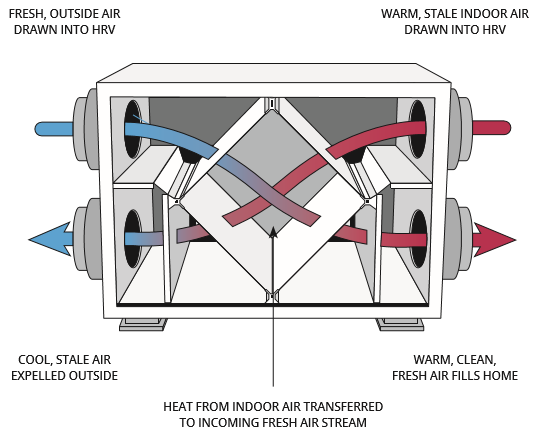Is HRV Worth It? Benefits and Drawbacks
Wiki Article
Discovering the Perks of Heat Recovery Ventilation for Power Performance in Residences
Heat Recovery Ventilation (HRV) systems provide homeowners a useful approach to enhancing energy effectiveness. By redeeming warmth from outward bound air, these systems can significantly lower heating & cooling prices. In addition, they supply a stable supply of fresh air, enhancing indoor air top quality and convenience degrees. As property owners consider sustainable options, comprehending the nuances of HRV systems becomes significantly crucial. What elements should one review prior to making such an investment?Recognizing Heat Recovery Ventilation Solutions

Exactly How HRV Enhances Indoor Air Top Quality

Power Financial Savings: The Monetary Benefits of HRV
Making best use of energy efficiency, heat recovery ventilation (HRV) systems supply substantial financial advantages for property owners. By recovering and recycling warm from exhaust air, HRVs markedly minimize heating & cooling expenses. This technology can cause energy financial savings of as much as 30%, relying on environment and usage patterns. Home owners frequently discover minimized utility expenses soon description after installation, making HRVs a monetarily smart investment in time. In addition, lots of areas offer incentives or refunds for energy-efficient upgrades, further boosting the economic allure. As power costs continue to increase, the cost-effectiveness of HRVs becomes increasingly clear. Generally, the unification of HRV systems not only promotes energy efficiency however additionally adds to lasting financial cost savings for families.The Environmental Influence of Heat Recovery Ventilation
A considerable ecological advantage of heat recovery ventilation (HRV) systems exists in their ability to lower total power consumption. By redeeming warmth from exhaust air and transferring it to incoming fresh air, HRV systems decrease the demand for energy-intensive home heating and cooling methods. This reduction in power need adds to lower greenhouse gas exhausts, as less nonrenewable fuel source is called for to keep comfy indoor temperatures. Additionally, HRV systems boost indoor air quality by successfully trading stale air with fresh outside air, minimizing reliance on mechanical air conditioning systems that can harm the setting. Generally, the implementation of HRV systems sustains lasting living Home Page practices and straightens with international efforts to battle environment modification by promoting power effectiveness in household setups.
Selecting the Right HRV System for Your Home
How can house owners assure they choose the right heat recovery ventilation (HRV) system for their needs? Initially, they ought to analyze their home's dimension and layout, as these variables affect airflow requirements. Next off, evaluating the system's effectiveness ratings is important, as higher rankings suggest much better performance and power financial savings. Home owners ought to additionally take into consideration installment and upkeep expenses, comparing various brands and models for value. Furthermore, it's essential to review noise levels, as some systems operate even more silently than others. Consulting with cooling and heating specialists can offer tailored recommendations based on particular home conditions. Taking a look at customer testimonials and service warranties can aid in making a notified decision, making sure that the chosen HRV system successfully boosts interior air high quality and energy efficiency.Often Asked Questions

Just how Usually Should I Tidy or Maintain My HRV System?
The regularity of cleansing or keeping a heat healing air flow (HRV) system usually depends upon use and environmental factors. Normally, it is a good idea to execute upkeep every 6 months to guarantee peak efficiency and air top quality.
Can HRV Systems Aid Minimize Moisture Levels Indoors?
HRV systems can successfully decrease interior moisture degrees by trading stale, humid air with fresh, drier air from outside. HRV Heat Recovery Ventilation. This procedure helps maintain a balanced indoor atmosphere, improving comfort and avoiding moisture-related issues
What Is the Life-span of a Normal HRV System?
The life-span of a common heat recovery ventilation (HRV) system varies, typically lasting between 10 to 15 years. Normal upkeep can prolong its efficiency and functional life, making sure peak efficiency throughout its usage duration.Are There Any Kind Of Noise Worries With HRV Systems?
Noise interest in HRV systems can emerge, specifically from follower procedure. Many contemporary devices are designed to reduce audio levels, guaranteeing they operate quietly while keeping effectiveness, which deals with possible disruptions in living environments. More InfoCan I Mount an HRV System Myself, or Do I Need a Specialist?
The individual contemplated whether to set up the heat recovery ventilation (HRV) system personally or work with a professional. Typically, while do it yourself installation is feasible, knowledge warranties correct performance and compliance with neighborhood building codes, boosting system effectiveness.Report this wiki page